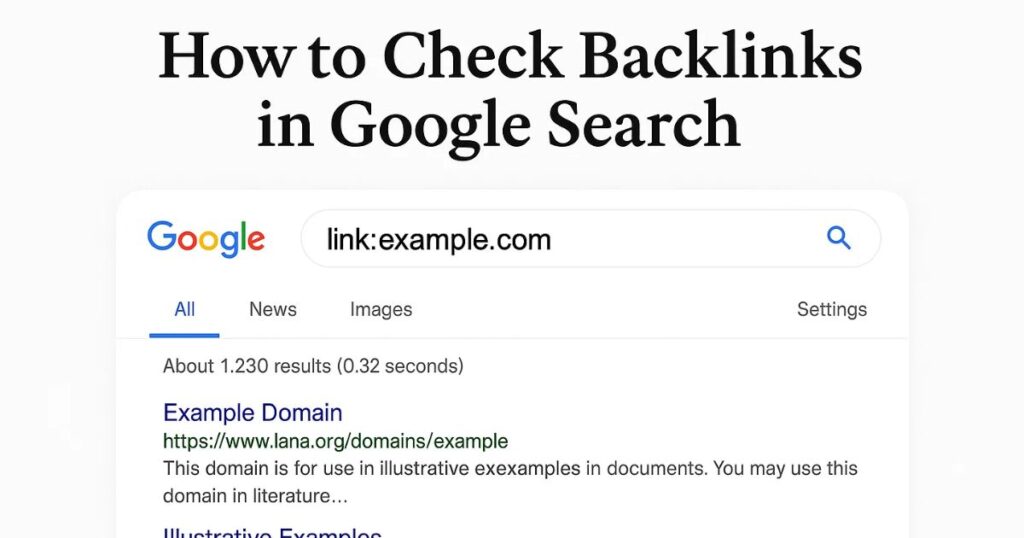How to Check Backlinks in Google Search – Ultimate Guide + 15 Proven Tips
What Are Backlinks and Why Do They Matter?
How to Check Backlinks in Google Search are links from other websites pointing to your site. In simple terms, they’re like “votes of confidence” from one site to another. The more high-quality backlinks you have, the more trustworthy and authoritative your website appears in Google’s eyes.
-
Improve domain authority
-
Boost organic rankings
-
Drive referral traffic
-
Increase credibility and trust
According to Google’s algorithm, backlinks are one of the top 3 ranking factors—so understanding them is crucial for SEO success.
How Google Treats Backlinks in Search Ranking
Google doesn’t treat all backlinks equally. The quality, relevance, and context of the linking website matter more than the quantity of backlinks.
-
High-authority links from reputable sources (e.g., news sites, .edu domains) carry more weight.
-
Nofollow vs Dofollow: Dofollow backlinks pass link juice, while Nofollow doesn’t—yet both are useful.
-
Contextual relevance: A backlink from a site in your niche is more valuable than from an unrelated one.
Can You Check Backlinks Directly on Google Search?
Technically, Google Search itself doesn’t offer a direct backlink checker. However, you can use Google Search Console or manual search operators to analyze some linking domains.
For example:
This operator used to show backlinks, but it’s now deprecated. Google now prefers users to rely on Google Search Console for backlink data.
Top Tools to Check Backlinks (Free + Paid)
Let’s explore the most effective tools for backlink analysis:
1. Google Search Console
-
Free, official tool by Google
-
Shows verified backlinks to your domain
-
Export link reports for analysis
2. Ahrefs
-
Premium SEO tool
-
Detailed backlink profiles, anchor text, and domain ratings
-
Recommended for agencies and professionals
3. SEMrush
-
Excellent for competitor backlink analysis
-
Powerful link audit features
-
Integrated with the disavow tool
4. Moz Link Explorer
-
Free limited access or Pro version
-
Useful for checking DA/PA and spam scores
5. Ubersuggest (by Neil Patel)
-
Budget-friendly alternative to Ahrefs
-
Provides backlink overview, referring domains, and more
6. Small SEO Tools Backlink Checker
-
Free and quick overview
-
Useful for beginners and small site owners
How to Use Google Search Console to Check Backlinks
Step-by-Step Guide
-
Log into your Google Search Console account
-
Select your domain property
-
Navigate to “Links” in the left panel
-
Under Top linking sites and Top linked pages, review who links to your website
Exporting and Analyzing Data
You can click on “Export External Links” to download the backlink data in CSV or Google Sheets format.
Use this data to:
-
Identify patterns
-
Find top-performing content
-
Spot unusual or suspicious links
How to Interpret Backlink Metrics
Understanding backlink metrics helps you make smarter SEO decisions.
DA (Domain Authority) vs PA (Page Authority)
-
DA refers to the strength of an entire domain
-
PA focuses on individual page strength
Anchor Text Distribution
Check if the anchor text linking to your site is natural and diverse. Repeated keyword-rich anchor text may appear manipulative.
Referring Domains
Focus on gaining links from unique domains instead of multiple links from the same one. More referring domains = better link diversity.
Best Practices for Manual Backlink Checking via Google

You can still do some manual checking using Google’s search operators:
Using Search Operators
-
yourdomain.com -site:yourdomain.comFinds mentions of your domain on other sites
-
"your brand name"Finds brand mentions that may not yet be linked
Tip: Use tools like BuzzSumo or Google Alerts to monitor brand mentions for backlink opportunities.
Red Flags in Toxic Backlinks
Toxic backlinks can hurt your rankings and even trigger penalties.
Common Patterns to Avoid
-
Links from spammy directories
-
Irrelevant or non-English domains
-
PBNs (Private Blog Networks) with duplicate content
How to Disavow Links
-
Create a list of toxic URLs/domains
-
Format them in a
.txtfile -
Upload via Google’s Disavow Tool
Tips to Build High-Quality Backlinks
-
Guest posting on niche-relevant blogs
-
Broken link building
-
Create shareable infographics
-
Write statistics-based content
-
HARO (Help A Reporter Out) opportunities
-
Resource page outreach
-
Skyscraper technique
-
Podcasts and interviews
Case Study: Ranking Boost from Quality Backlinks

A mid-size tech blog implemented a white-hat guest posting strategy targeting DR70+ websites. Over 3 months:
-
Organic traffic increased by 62%
-
Keyword rankings improved for 300+ terms
-
Bounce rate dropped due to better content and referral traffic
The key? Backlinks from relevant, high-authority domains with contextual placement.
FAQs
1. How do I find who links to my website?
Use Google Search Console under the “Links” section to find websites linking to you. You can also utilize tools like Ahrefs or SEMrush for more in-depth insights.
2. Can backlinks hurt my site?
Yes. Toxic backlinks from spammy or irrelevant sites can harm your rankings. It’s important to audit and disavow them if needed.
3. What’s a good number of backlinks?
There’s no fixed number. Focus on quality over quantity. A few strong links from high-authority sites are better than hundreds of spammy ones.
4. Are Nofollow links useful?
Yes. Nofollow links don’t pass link juice, but they help build brand awareness, referral traffic, and a natural link profile.
5. How often should I check backlinks?
Monthly audits are a good practice, especially if you’re running SEO campaigns or seeing unusual ranking drops.
6. Can I remove bad backlinks?
You can reach out to webmasters for removal or use the Disavow Tool in Google Search Console.
Conclusion
The Smart Way to Monitor and Improve Your Backlink Profile
Mastering backlink analysis is essential for anyone serious about SEO. While Google doesn’t offer a full backlink checker directly in search, you have powerful tools at your disposal—especially Google Search Console and top industry platforms like Ahrefs and SEMrush.


